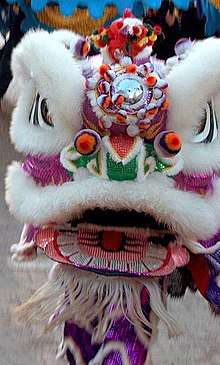Nian
| Nian | |||||||||||
 Southern Chinese lion dance is said to relate to driving away the Nian | |||||||||||
| Traditional Chinese | 年獸 | ||||||||||
|---|---|---|---|---|---|---|---|---|---|---|---|
| Simplified Chinese | 年 | ||||||||||
| Literal meaning |
年 Year 年獸 Year beast | ||||||||||
| |||||||||||
According to Chinese mythology, a Nian (simplified Chinese: 年兽; traditional Chinese: 年獸; pinyin: nián shòu) is a beast that lives under the sea or in the mountains. The character Nian more usually means "year" or "new year". The earliest written sources that refer to the Nian as a creature date to early 20th century. As a result, it is unclear whether the Nian creature is an authentic part of traditional folk mythology, or a part of a local oral tradition which was recorded in the early 20th century. Nian is one of the key characters in the Chinese New Year, with scholars citing it as the reason behind several practices during the celebration such as wearing red clothing and creating noise from drums and fireworks.[1]
Modern legends
Once every year at the beginning of Chinese New Year, the Nian comes out of hiding to feed, but during winter since food is sparse he would go to the village. He would eat the crops and sometimes the villagers, mostly children.[2] There are several accounts as to how it looked like such as the way some sources cited that it resembles a flat-face lion, with a dog's body and prominent incisor.[3] Other authors described it as larger than an elephant with two long horns and many sharp teeth.[4] The weaknesses of the Nian are purported to be a sensitivity to loud noises, fire, and a fear of the color red.
Some local legends attribute the Chinese lion dance (Chinese: 舞龍舞獅) to the legend of the Nian. The tradition has its origins in a story of a Nian's attack on a village. After the attack, the villagers discussed how to make the Nian leave them in peace. Since it was discovered that the beast was afraid of the color red, people would put red lanterns and spring scrolls on their windows and doors.[5] They would also leave food at their doorstep in a bid to divert it from eating humans.
The traditions of firecrackers, red lanterns, and red robes found in many Lion Dance portrayals originate from the plan the villagers had in which drums, plates and empty bowls were hit, red robes were worn, and firecrackers were thrown, causing loud banging sounds that they hoped would intimidate the Nian. According to this same myth, captured by Hongjun Laozu, an ancient Taoist monk, and Nian became Hongjun Laozu's mount.
Ancient sources
Various aspects of cultural practices relating to Chinese New Year is now included as part of the Nian legend. These cultural practices are recorded in ancient texts, though none of them refer to a creature called Nian
The Erya records that the character Nian (年) was first used to mean the year during the Zhou dynasty, replacing the different terms used in previous eras. The Shuowen Jiezi records that the character Nian meant "ripeness of grains", and was composed of the character "he" (禾, rice plant) and "qian" (千, indicating the sound), and quotes the Chunqiu which uses it in the sense of a great harvest.
The attributes of the Nian creature in the modern legend, of fear of noise and fire, correlates with ancient legends relating to the use of firecrackers to drive off ape-like creatures in the mountains called shanxiao (山魈), first recorded in the Shanhaijing.
The practice of sweeping and cleaning at the start of the year is recorded in Zhou dynasty sources as intended to ward off plague spirits, and the practice of using music and drama to receive gods and ward off plague spirits is also recorded from the same era. The creature's role in the celebration of the Chinese New Year is highlighted by the way the Chinese call this holiday as Guo Nian, which means "pass over Nian" or "overcome Nian."[6]
See also
- Chinese mythology in popular culture
- Dragon
- Three Delivery (animated show where the Nian appeared in an episode)
- Yule Goat
References
- ↑ Laban, Barbara (2016-02-08). "Top 10 Chinese myths". the Guardian. Retrieved 2018-08-23.
- ↑ CTI Reviews (2016). The Search for Modern China: World history, Central Asia. Cram 101 Textbook Reviews. ISBN 9781478456711.
- ↑ Flake, Ben (2014-01-31). "It Lurks". The Paris Review. Retrieved 2018-08-23.
- ↑ Yuan, Haiwang (2006). The Magic Lotus Lantern and Other Tales from the Han Chinese. Westport, CT: Libraries Unlimited. p. 168. ISBN 1591582946.
- ↑ Espiritu, Roddy (2013). Tagtaginep - My Dream of Opportunity. Bloomington, IN: Xlibris Corporation. p. 82. ISBN 9781479751051.
- ↑ "The Story of Chinese New Year (年的传说)". www.chinesenewyearfestival.org. Retrieved 2018-08-23.